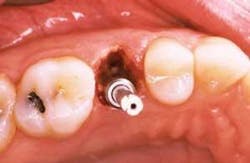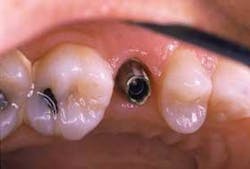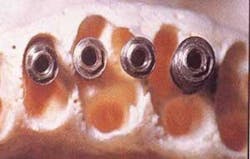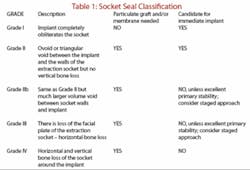Immediate implant placement and the Socket Seal classification
by Jack T. Krauser, DMD, and Avi Schetritt, DMD
For more on this topic, go to www.dentaleconomics.com and search using the following key words: Dr. Jack Krauser, Dr. Avi Schetritt, dental implants, immediate implant placement, socket preservation, ICOI.
The end goal of prosthetic replacement of teeth following tooth loss is to provide a functional restoration that is harmonious with the remaining natural dentition. To achieve this goal, hard and soft tissue need to be present in adequate volumes and quality.
The current increase in the use of endosteal dental implants has placed greater importance on the preservation of the alveolar ridge in order to ensure optimal implant placement. Resorption of the alveolar ridge is common after extraction and presents a clinical challenge to ideal implant placement, especially in the esthetic zone.
Socket preservation techniques involve minimally traumatic extraction followed by immediate grafting of the extraction sockets using particulate bone graft materials with or without membranes. These socket preservation techniques have been shown to reduce alveolar ridge dimensional changes following extraction. Although socket preservation techniques are beneficial, soft tissue closure and graft containment can be difficulties encountered with these techniques.
In order to preserve the extraction socket dimensions, immediate implant placement at the time of extraction has been proposed. Briefly described, the technique involves a minimally traumatic extraction of the tooth.
The appropriate implant osteotomy is carried out and the implant is then placed. Typically, the osteotomy will extend beyond the apex of the extraction socket in order to provide primary stability of the implant.
Voids between the implant and the extraction socket walls are filled using a particulate bone graft material (Figures 1 and 2).
Immediate implant placement into the fresh extraction socket in conjunction with bone augmentation and/or socket preservation techniques has been reported using bioabsorbable or nonbioabsorbable membranes, as well as a variety of particulate bone graft materials. These immediate implant placement techniques have shown comparable results to that observed in delayed placement. They also have the added benefit of shortening the timeline to the final restoration.
Immediate implant placement into extraction sockets should only be considered if implant stability can be achieved. When primary stability is not possible, a staged approach should be used.
Unlike dental implants, sockets are not round and the extent that an implant fills the socket will vary (Figure 3). Krauser and Hahn have developed the Socket Seal classification (Table 1) which describes the extent to which an implant fills the extraction socket.
This classification can serve as a guideline to help the clinician determine if a staged approach is indicated rather than an immediate placement.
Generally speaking, Krauser and Hahn recommend immediate implant placement into an extraction socket when there is good primary implant stability, no horizontal bone loss, and no or minimal vertical bone loss (i.e., Grades I, II, and some Grade III).
For all other situations (Grades IIb, III, and IV), a staged approach is generally recommended.
Socket preservation techniques are beneficial in preserving alveolar hard and soft tissues. When intact or nearly intact extraction sockets are present, an immediate implant placement technique offers the advantages of the socket preservation technique and reduces the time required to achieve a final restoration.
Clinical judgment must be used to determine the appropriateness of an immediate implant technique for any given situation. The Krauser and Hahn Socket Seal classification can be used as a guideline to aid in clinical decision–making.
Editor's Note: References available upon request.
Jack T. Krauser, DMD, is a private practice periodontist in Boca Raton and North Palm Beach, Fla. He has authored several chapters and journal articles and has lectured frequently at national and international events. His areas of interest are bone regeneration, implant surfaces, and guided implant surgery. He is a member of several periodontic and implant societies and is the current secretary of the ICOI.
Avi Schetritt, DMD, is a periodontist in private practice in Miami, Fla. He has lectured nationally and internationally on implant dentistry and soft tissue grafting around teeth and implants. Reach him via e–mail at [email protected].




